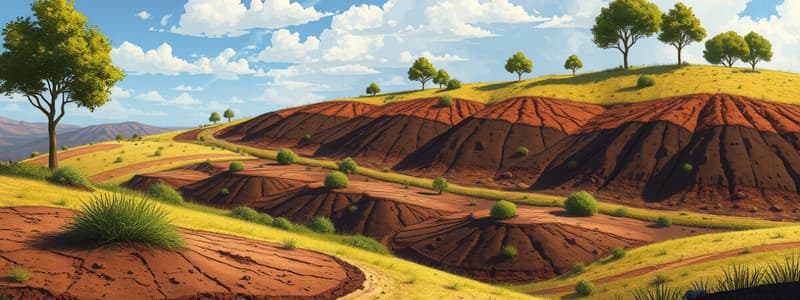Podcast
Questions and Answers
Why do we classify soils?
Why do we classify soils?
To take advantage of research and experience at one location to predict the behavior of similar soil in another and to tell us what is where.
What classification system is used in the USDA-NRCS system?
What classification system is used in the USDA-NRCS system?
- Local classification
- USDA-NRCS system (correct)
- European classification
- FAO classification
What does F.A.O stand for?
What does F.A.O stand for?
Food and Agriculture Organization
What are the 5 factors of soil development represented by CLORPT?
What are the 5 factors of soil development represented by CLORPT?
What are the 6 levels of Soil Taxonomy?
What are the 6 levels of Soil Taxonomy?
What is Muck?
What is Muck?
How many soil orders are there?
How many soil orders are there?
Soil orders are based on what?
Soil orders are based on what?
How many soil series are classified in Texas?
How many soil series are classified in Texas?
What do soil order names all contain?
What do soil order names all contain?
Which soil order is productive for crops and can hold water?
Which soil order is productive for crops and can hold water?
What is the definition of Andisols?
What is the definition of Andisols?
What are Aridisols typically characterized by?
What are Aridisols typically characterized by?
What defines Entisols?
What defines Entisols?
What are Gelisols characterized by?
What are Gelisols characterized by?
What are Histosols rich in?
What are Histosols rich in?
What are the characteristics of Mollisols?
What are the characteristics of Mollisols?
What defines Oxisols?
What defines Oxisols?
What are Spodosols typically found under?
What are Spodosols typically found under?
What are Ultisols known for?
What are Ultisols known for?
What are Vertisols characterized by?
What are Vertisols characterized by?
What is a soil Series?
What is a soil Series?
What is the Texas state soil?
What is the Texas state soil?
What is a key technique for mapping soil?
What is a key technique for mapping soil?
What is a soil Survey?
What is a soil Survey?
What do Land Capability Classes range from?
What do Land Capability Classes range from?
What defines Class I land capability?
What defines Class I land capability?
What is the limitation of Class 2 land?
What is the limitation of Class 2 land?
What is Prime farmland?
What is Prime farmland?
What are the characteristics of Class 4 land?
What are the characteristics of Class 4 land?
Class 5 land capability has limitations that restrict what?
Class 5 land capability has limitations that restrict what?
What is the main characteristic of Class 6 land?
What is the main characteristic of Class 6 land?
What does Class 7 land indicate?
What does Class 7 land indicate?
What does Class 8 land imply?
What does Class 8 land imply?
What is Permafrost?
What is Permafrost?
Flashcards are hidden until you start studying
Study Notes
Soil Classification Overview
- Soil classification helps predict soil behavior and manage land effectively.
- The USDA-NRCS classification system is used in over 50 countries worldwide.
Soil Development Factors
- CLORPT is an acronym for the five factors of soil development: Climate, Organism, Relief, Parent Material, and Time.
Soil Taxonomy Structure
- Soil taxonomy contains six levels: Order, Suborder, Great Group, Sub-group, Family, and Series.
Types of Soil
- Muck: Decomposed material with high humidity content.
- Soil orders represent the most general classification category.
Texas Soil Series
- Over 1,300 soil series identified in Texas, classified into nine soil orders.
- Seven prominent orders include Alfisols, Aridisols, Entisols, Inceptisols, Mollisols, Ultisols, and Vertisols.
Soil Order Characteristics
- Alfisols: Nutrient-rich, productive for crops, comprise about 10% of global land.
- Andisols: Volcanic glass content, high water retention, make up about 1% of global land.
- Aridisols: Found in desert areas, low moisture, make up 12% of global land.
- Entisols: Recently formed soils lacking horizon development, make up 16% of global land.
- Gelisols: Contain permafrost, found in cold regions, comprise 9% of global land.
- Histosols: Organic-rich, saturated soils, found in bogs and wetlands, make up 1% of global land.
- Inceptisols: Moderately weathered, diverse characteristics, make up 17% of global land.
- Mollisols: Dark soil, high organic content, found primarily in grasslands, make up 7% of global land.
- Oxisols: Highly weathered, found in tropical areas, make up 8% of global land.
- Spodosols: Acidic subsoils found under coniferous forests, make up 4% of global land.
- Ultisols: Formed in humid areas, susceptible to weathering, make up 8% of global land.
- Vertisols: Have shrink-swell clay, high fertility, make up about 25% of global land.
Mapping and Assessment Techniques
- Soil series characterized by a range of properties, named for first identification location.
- Houston Black Soil designated as the Texas State Soil.
- Soil surveys involve systematic examination and mapping of soil characteristics.
- Soil pits allow detailed examination of soil profiles, including color, texture, and structure.
Land Capability Classes
- Class I: Versatile, low erosion risk, deep, well-drained soils suitable for a variety of crops.
- Class II: Requires careful management; few limitations for crops.
- Class III: Designated as prime farmland for producing food and fiber.
- Class IV: Limited plant choices and requires careful management.
- Class V: Soil limitations restrict certain crops; often wet or stony.
- Class VI: Unsuitable for crops but viable for special uses like orchards.
- Class VII: Impractical for management improvements in pastures or ranges.
- Class VIII: Unproductive for crops but may allow recreational activities.
Permafrost
- Defined as soil, rock, or sediment frozen for over two consecutive years, typically found in extremely cold climates.
Studying That Suits You
Use AI to generate personalized quizzes and flashcards to suit your learning preferences.




